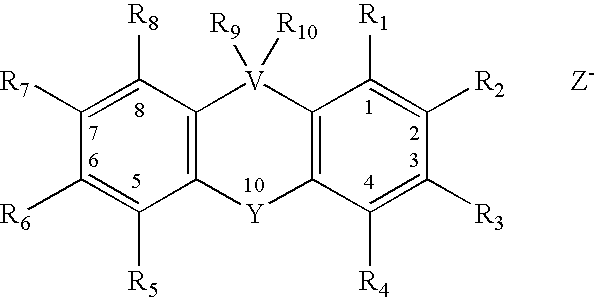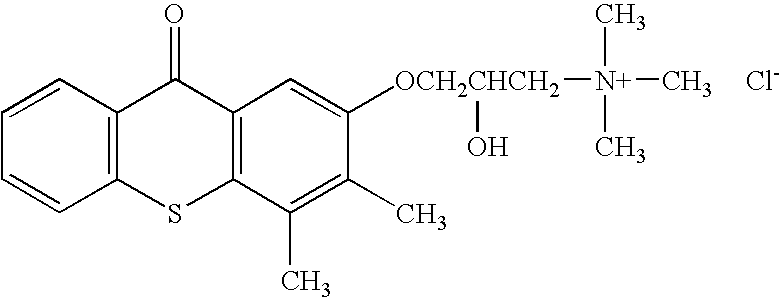Small molecules for the reduction of high blood glucose level
a small molecule and glucose level technology, applied in the field of heterocyclic compound family, can solve the problems of increased formation and release, igt and hyperglycemia, and the rate-limiting step of glucose utilization and storag
- Summary
- Abstract
- Description
- Claims
- Application Information
AI Technical Summary
Benefits of technology
Problems solved by technology
Method used
Image
Examples
example 1
CCcompound1 Does Not Alter Blood Glucose Level in Normal (Non-Diabetic) Mice without Glucose Challenge
[0057]Female C57 / BL / 6 mice (25-27-g body weight) were deprived of food for 2 hours and then injected with 4.5-mg / kg of CCcompound1. Blood samples for glucose measurements were taken from the eyes (canthus) just before the administration of CCcompound1 (0 min) as well as 30 min and 120 min after the administration of CCcompound1. Glucose concentrations in whole blood samples were immediately measured with the Fast Glucose C test. The data are the mean±std.dev. of 5 determinations, i.e. one determination with each of the 5 animals.
[0058]The data presented in TABLE 2 show that acute treatments with CCcompound1 do not change the blood glucose level in mice that were deprived of food for 2 hours. In this experiment, the period of food deprivation was short enough that compensatory mechanisms could maintain the blood glucose level near the normal 5-mM value. The condition employed also re...
example 2
CCcompound1 (CC1), CCcompound3 (CC3), and CCcompound19 (CC19) each Reduce Blood Glucose Level in Glucose Tolerance Test Performed with Normal Mice
[0059]C57 / BL / 6 female mice weighing 22-23-g and fasted for 14 hours before intraperitoneal (i.p.) administration of glucose (3-g / kg) were used. None of the animals received any food during the experiment other than glucose. The animals received i.p. injections of 4.5-mg / kg of CCcompound1, CCcompound3, or CCcompound19 either 1 hour or 24 hours prior to glucose administration as indicated in TABLE 3. Blood samples were taken from the eyes (canthus), and glucose concentrations in whole blood samples were immediately measured with the Fast Glucose C test. Each group included six animals. The data, shown in TABLE 3, are the mean±std. dev. of 6 determinations, i.e. one determination with each of the six animals. In this and all subsequent experiments the values at 0 min reflect glucose concentration in blood samples collected 1-5 minutes prior t...
example 3
Concentration- and Time-Dependent Effects of CCcompound1 (CC1) on Blood Glucose in Glucose Tolerance Test Performed with Normal Mice
[0061]Female C57 / BL / 6 mice weighing 22-23-g and fasted for 14 hours prior to i.p. glucose administration (3-g / kg) were used. None of the animals received any food during the experiment other than glucose. The animals received i.p. injections of 2.0 or 4.5-mg / kg of CCcompound1 either 30 min, 60 min or 120 min prior to glucose administration. Blood samples were taken and glucose concentrations were immediately measured as described earlier. Each group included six animals. The data are the mean±std. dev. of 6 determinations, i.e. one determination with each of the six animals. “-min” indicates the length of period in minutes elapsed between the administration of CCcompound1 (first) and glucose (second).
[0062]The results, shown in TABLE 4, indicate that, within the margin of experimental error, CCcompound1 was about as effective at the 2-mg / kg dose as at t...
PUM
| Property | Measurement | Unit |
|---|---|---|
| concentration | aaaaa | aaaaa |
| time | aaaaa | aaaaa |
| time | aaaaa | aaaaa |
Abstract
Description
Claims
Application Information
 Login to View More
Login to View More - R&D
- Intellectual Property
- Life Sciences
- Materials
- Tech Scout
- Unparalleled Data Quality
- Higher Quality Content
- 60% Fewer Hallucinations
Browse by: Latest US Patents, China's latest patents, Technical Efficacy Thesaurus, Application Domain, Technology Topic, Popular Technical Reports.
© 2025 PatSnap. All rights reserved.Legal|Privacy policy|Modern Slavery Act Transparency Statement|Sitemap|About US| Contact US: help@patsnap.com



